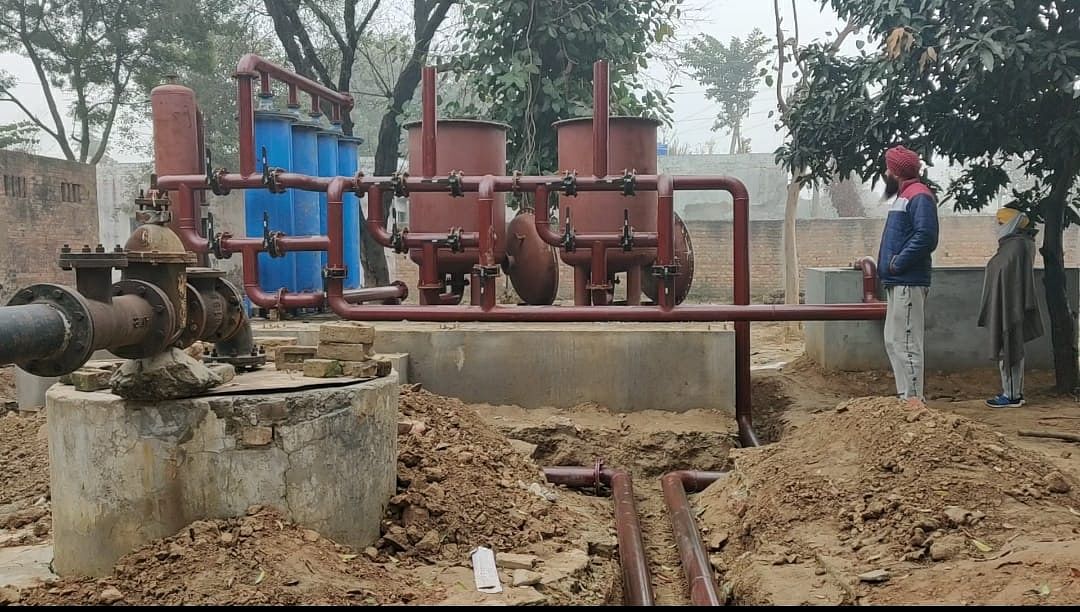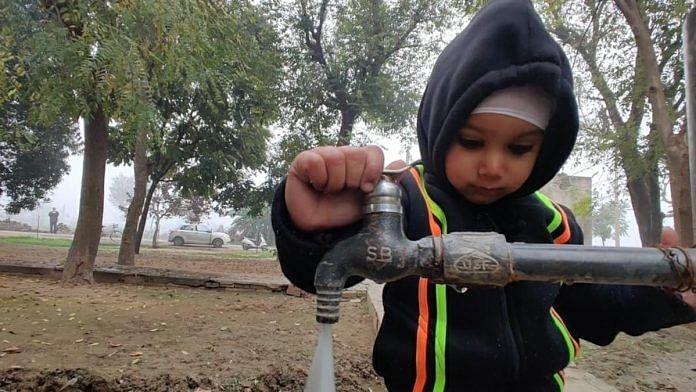Rupnagar: Jasveer Kaur, 43, who lives on the outskirts of Dumna village in Punjab’s Rupnagar district, suddenly has a luxury she never had before — time. With the Narendra Modi government’s ‘Har Ghar Nal Se Jal’ scheme bringing assured access to water twice a day — within the comfort of her own home — she has kissed a long, painful struggle goodbye.
“The frequency of water supply in my house was very irregular… The motor of my submersible (pump) would get fried every second day, after which I had to beg the neighbours for water,” she told ThePrint. “Sometimes they agreed and sometimes they didn’t, which made my life hectic every day as my work was delayed.”
There is a monthly fee of Rs 175 that she has to pay for the tap water connection under the Nal Se Jal programme, which aims to connect all rural households with drinking water supply pipelines by 2024, but Kaur doesn’t mind.
“This assured twice-a-day tap water supply has changed my life as I can spare time to do other, more productive things,” added Kaur.
Har Ghar Nal Se Jal was launched in August 2019 as the big public infrastructure programme of the Modi government’s second term. It’s part of a larger welfare push that has seen the government target open defecation, and distribute 8 crore LPG connections under the Ujjwala scheme before the deadline in 2019.
The scheme has a massive outlay of Rs 3.6 lakh crore, of which the central government is contributing Rs 2.08 lakh crore, with the rest coming from the states.
Rupnagar is one of three districts in Punjab, and among 52 across India, that have achieved 100 per cent coverage under Nal Se Jal. The three Punjab districts — Rupnagar, Sahibzada Ajit Singh Nagar and Shaheed Bhagat Singh Nagar — have an estimated 1.06 lakh rural households across 1,180 villages.
Kaur’s elation finds echo among other residents. However, some issues are yet to be ironed out — primarily, complaints about the quality of water in some villages.
While a filtration system has been installed in Dumna, potable water remains a struggle for residents of Latheri, another village in Rupnagar. There are also concerns that the flat rate of Rs 150-175/month is leading to waste since people now use water without worrying about fat bills.
ThePrint reached Jaspreet Talwar, Principal Secretary, Water Supply and Sanitation Department, through calls and texts for a comment, but hadn’t received a reply until the time of publishing this report.
Officials in the Punjab Water Supply and Sewerage Board, who didn’t want to be named, said it is early days for the scheme yet, but added that efforts are underway to address all concerns.
Also Read: In these Haryana villages, PM Modi’s Nal Se Jal has ended a painful daily chore for women
Cheers and concerns
Gurdas Singh, another Dumna resident, is all praise for the “robust operation and maintenance” of tap water connections under Nal Se Jal.
“When we complain about broken pipes, the water board promptly repairs it, within an hour or two,” he said.
Meanwhile, Swarn Singh, a 51-year-old panchayat member in the village, explained the set-up of the water purifier and tank installed under the scheme.

“We have a water filtration plant installed under this scheme that will be in operation in a few days to provide purified water to everyone in the village. We have a reliable water supply,” he said, adding that the quality has improved too.
“Earlier, water quality in the village was very impure with the TDS (total dissolved solids) level going up to 400 mg/L,” he said. “But now it has improved, as we have a new deeper connection at 500 feet. It was at 300 feet earlier,” added Swarn Singh.
A TDS level of 400 mg/L would not generally constitute a health hazard. However, high TDS levels can render the water hard, making it difficult to create lather. They can also result in deposits on pipelines and thus dent their efficiency.
Among the provisions under the Nal Se Jal scheme is a requirement to set up village-specific ‘pani samitis’ — or water committees — to decide matters such as tariff. Each committee is supposed to comprise 10-15 members, of which 50 per cent should be women.
According to Kuldeep Kaur, a pani samiti member in Dumna, they are currently working to curb wastage of water since they are yet to be informed about “other work”.
“There are four women among the 10 samiti members of the village. Our work is to spread awareness about reducing water wastage in the village. We campaign door-to-door,” she added.
Also Read: In J&K’s Ganderbal, Nal Se Jal has reached all rural houses. But there’s a catch for some
The road ahead
The implementation and functioning of Nal Se Jal in the state is overseen by the Punjab Water Supply and Sewerage Board, which comes under the Water Supply and Sanitation Department. Among the major aims of the board under the scheme has been regularising illegal connections across villages and replacing old rusted pipelines. These old pipes had leaks in many places, and replacing them has helped conserve water.
However, there are worries about the emergence of a new cause of wastage — profligate use of water blamed on the flat rate imposed in villages, because a consumption of 20 litres costs the same as two litres.
“There are 260 households in this village,” Latheri sarpanch Tehal Singh said. “A lot of water is wasted due to the flat rate under the Nal Se Jal scheme. Water consumption should be metered.”
He also flagged contamination as a concern. “Most of the water under Nal Se Jal is from submersibles… the groundwater is very dirty. The water is impure. We need pure water for drinking from these tap connections,” he added.
Asked about the concerns, a senior official from the Punjab Water Supply and Sewerage Board said the “water supply connection is charged at a flat rate until now as the operation and maintenance of connections in these districts and villages is still being done by the government and not by pani samitis”.
“We are in the process of making the pani samitis aware of their functions, such as deciding the kind of infrastructure required to make water potable in their villages, such as filtration plants, and how it is to be properly maintained,” the official added.
“After this, meters will be set up. The pani samitis will then charge households for water on consumption basis and maintain the infrastructure with the money collected,” the official said.
Also Read: Modi govt begins survey of 6 cr tap connections in villages to assess water quality, quantity




Haven’t these people heard of storing water in low-cost, affordable 500-1000 gallon fiber-glass tanks, for use when taps runs dry…a system which proliferates all across the developing world???
Modi knows Indians are lacking basic needs , it’s a great help to women , not sure why congress never planed for these kind of scenes in their 60 years of power .
The luxury of free time is the reason behind such large scale protests on farm laws. People in rural Punjab have lots of free time and nothing better to do. Hence, they are creating nuisance.
Earlier they were engaged in one task or the other. Naturally, indulging in such non-sensical activities was not an option at all. The privilege of “free time” is not meant for all. Unfortunately, the government does not understand this.